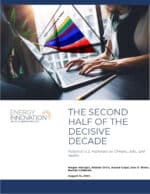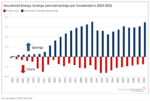America faces a fork in the road starting in January 2025, with two climate and energy policy pathways that are highly divergent. These future policy pathways result in stark differences for our health, our pocketbooks, the economy.
To better understand the pathways before us, Energy Innovation examined three sets of policies:
- Projected impacts of recently adopted policies, including Inflation Reduction Act, CHIPS Act, and Bipartisan Infrastructure Law as well as finalized U.S. EPA rules and major state policies through the end of July of this year.
- Continued U.S. leadership, meaning policies necessary to hit America’s Paris Agreement target of 50-52 percent emissions reductions by 2030 and net zero emissions by 2050.
- The climate and energy provisions of Project 2025.
Our model finds the Continued Climate Leadership scenario creates more jobs, increases GDP, improves public health, and generates more household energy savings compared to the suite of Project 2025 policies.
Energy Innovation undertook this analysis to bring nonpartisan research and quantitative grounding to a rhetorical environment so all Americans – businesses, homeowners, and policymakers – can come to their own conclusions about how to weigh the climate and energy futures on the table.






